The first ‘official’ gold discovery at Fairbanks was in 1902 on Pedro Creek. However, prospectors had been quietly working placer deposits along the creeks in the area since 1878. Their activities though had gone largely unnoticed, and were overshadowed by better-known finds at Circle, Fortymile, and Rampart. Felix Pedro’s 1902 discovery would likely have played out the same way had it not been for trader Elbridge Truman (ET) Barnette.
But For Chance
A year earlier, Barnette had been on his way to build a permanent trading post at Tanacross on the Tanana River. Circumstances found him ‘stuck’ instead at Chena River, where he set up a temporary trading post. Whilst there, he traded with a few prospectors in the area. One of them, Italian-born migrant Felix Pedro, told him there were promising signs of placer gold close by.
When word reached Barnette in August 1902 that Pedro had found the gold, he promptly turned his temporary trading post into a permanent one. At the same time, he and a group of associates headed out to Pedro Creek to claim as much as they could for themselves.
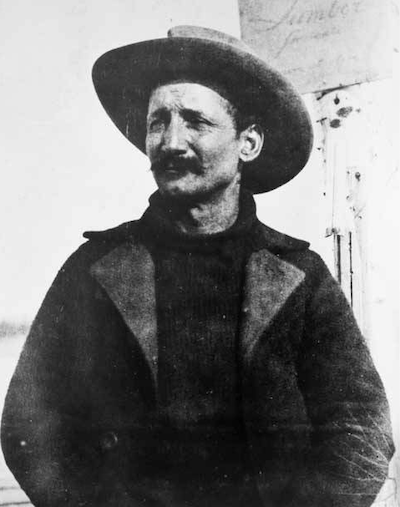
In July of 1902, Felix Pedro discovered gold north of Fairbanks. This discovery would bring thousands of miners to Alaska, creating one of the last true “gold rushes” on Earth.
Planning A Gold Rush
Claiming done, Barnette turned his attention to building up his trading business. He sent an emissary to Dawson City to spread word about Pedro’s find around the Klondike gold fields.
Obligingly, many of the miners still at the Klondike headed to Chena River but most were disappointed when they got there. The best land was already claimed and easily accessible lucrative deposits were few and far between. Some found jobs working, ironically, on Barnette’s claims. Many more simply left.
Early Placer Gold Mining At Fairbanks
Placer mining around Fairbanks developed rapidly. As the surface deposits depleted, attention turned to the deeper deposits and quartz lodes, hidden by tons of frozen overburden. Although these deposits could be mined quickly and effectively with better equipment, few miners in the early days were able, or prepared, to outlay the required cash.
Instead, most persevered with whatever tools they had available but their slow hard work did eventually pay off. However, official reports note that much of the equipment was primitive, even by early 1900 standards!
Fairbanks/Chena And Alaska Railroads
The completion of the Fairbanks/Chena railroad in 1904/05 made it possible to import heavier equipment for mining and processing the deeper placers and lode deposits. As a result, placer production increased significantly over the following decade. By the end of 1910, the area had produced an estimated $48,653,300 worth of placer gold. That’s over $1.5 billion dollars in today’s money!
1923 saw the completion of the Alaska Railroad to the coast, allowing direct freight delivery. Heavy mining equipment – dredges and hydraulic systems – began arriving in Fairbanks in the 1920s, and large-scale dredging started in 1928.
The dredges worked on low-grade waste ore left by earlier placer mining and on deeper placers as they were exposed by hydraulics. By 1940, the massive machines were consistently producing well over a hundred ounces of gold a year. In 1940 alone, they produced some 209,000 ounces.
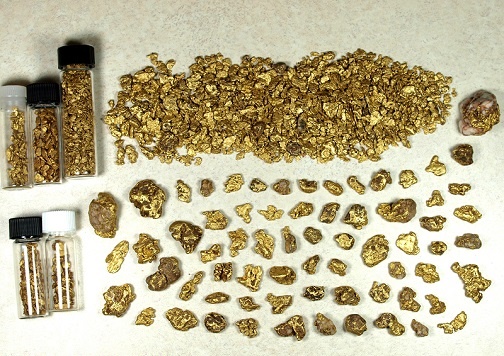
All of this gold was found recently within 50 miles of Fairbanks, Alaska. A small-scale placer miner recovered these using a loader and a trommel. The bigger nuggets weigh about 1/2 ounce. Not pictured is roughly 100 ounces of fines that were also mined this season also. ~$20,000 value pictured.
Fairbanks’ Famous Dredges
Historically, Fairbanks’ placer workings produced 38% (>7,800,000 ounces) of Alaska’s total placer gold, much of it courtesy of the dredges. Today, several of them still sit where they ceased operating over half a century ago. The massive Goldstream Dredge #8 at the old El Dorado mine is open to the public. Dredge #3 (Chatanika Gold Dredge) is on private property but the owners allow people to visit.
The Davidson Ditch
The Davidson Ditch (1928) was pivotal to the success of large-scale placer mining. A 90-mile system of open canals, pipelines and tunnels, it piped water from further upstream for the dredging and hydraulic operations. When the dredges ceased operations in the early 1960’s, the ‘ditch’ was used to generate electricity.
Also Read: 15 Historic Photos of Hydraulic Miners in Action
Early Lode Mining At Fairbanks
Fairbanks’ placer deposits predominantly originate as gold-bearing quartz veins, or lodes. The first of these lodes was discovered north of Fairbanks in the autumn of 1903. The lodes were hand-mined prior to the arrival of heavier equipment in 1905.
Interestingly, in his 1973 report to the Department of the Interior, Bruce Thomas noted that hand-mining methods persisted even after modern equipment was installed.
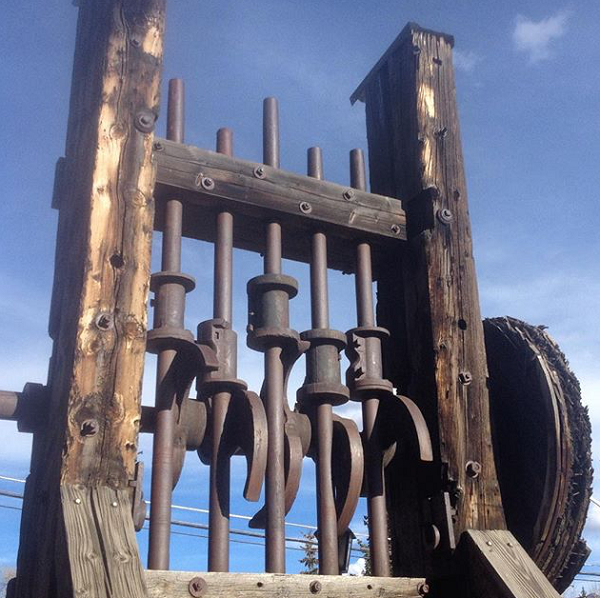
When the gold is locked up in rock, it must be crushed. Stamp mills like this one were used to pulverize gold-bearing ores.
The first mill began operating in 1909. Five more were in operation by 1913 and lode-gold production significantly increased over the following decade. By the time the government halted mining in 1942, lode mining had exceeded total gross non-dredging placer production.
After the war, some attempted to re-open their mines but in most cases, it proved unviable. All up, Fairbanks’ gold lodes had produced around 241,000 fine troy ounces of gold.
Read: Alaska’s Largest Gold Nugget Discovered
The Development Of A Mining Industry In Fairbanks
It’s worth noting that the type of mining personnel in Fairbanks also matured during the lode-mining period. The original prospectors, experienced in gold rush conditions, had a ‘gophering’ approach to mining. As mining became more mechanized, haphazard prospectors were replaced by experienced miners. They brought order and a systematic approach to mining and plant that led to improved throughput and better returns.
Fairbanks Lode Mining History Timeline
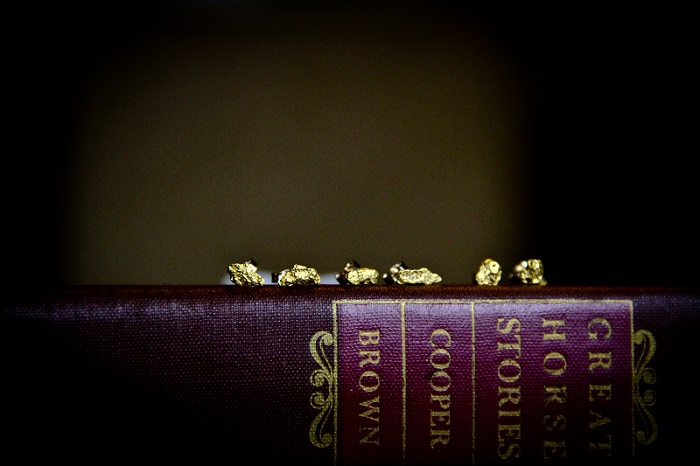
Small Alaska gold nuggets made into some lovely stud earrings. Made by Slab Creek Designs.
Public Panning Areas In Fairbanks
Fairbanks has several venues for visitors to learn how to pan, and to experience panning. Gold Daughters and Gold Dredge 8, part of the El Dorado Gold Mine tourist attraction, are the two largest.
Although most of the creeks around Fairbanks still contain placer gold, almost all the land is currently claimed or privately owned and public panning is not permitted. Prospecting is permitted on most government lands, but it would be wise to check with the relevant government departments first.
Pedro Dome panning area: this is a small 1-acre area set aside for public panning near the Pedro Monument. Metal detectors, pans, sluice and rocker boxes can be used. Access is via the Steese Highway. There are no facilities at the site.
Bachelor Creek panning area: eighty miles further north along the Steese Highway. The main trail into the site is 4WD only. Mini suction dredges, metal detectors, pans, sluice and rocker boxes are allowed. The site has no facilities and requires a degree of physical fitness.
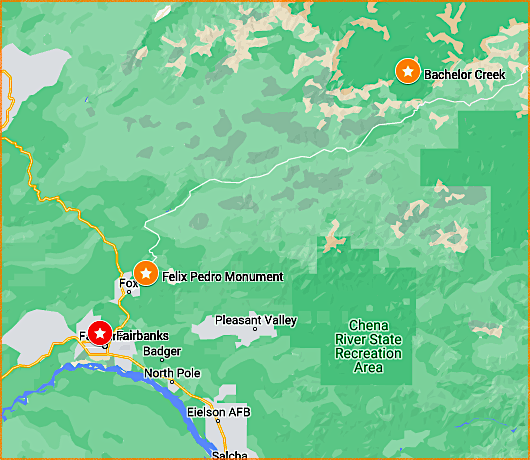
If you want to get away from the typical tourist sites and do some authentic prospecting, there are public panning sites at the Felix Pedro Monument and on Bachelor Creek, northeast of Fairbanks.
Fairbanks Mining Museums
The Alaska Mining Hall of Fame Museum is on 1st Avenue and honors the 100+ pioneers who have been inducted into the Hall of Fame since 1997.
The Alaska Gold Mining Museum is at Gold Daughters.
The Gold Dredge 8 interactive mining museum at El Dorado Gold Mine offers tours to some ice age fossils close to the mining camp.
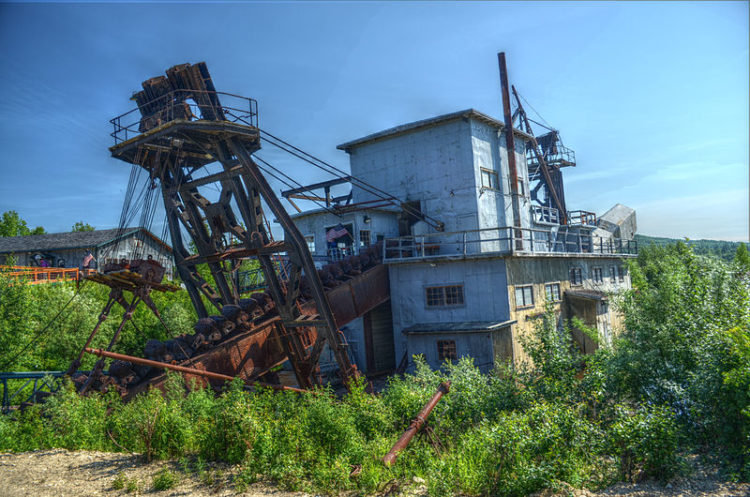
Gold Dredge 8 is one only a handful bucket line dredges still in existence today. It is a popular attraction for Fairbanks visitors. Most of these old dredges were dismantled, scrapped, or simply rotted away over the years.
Alaskaland’s Pioneer Museum tells the stories of early mining pioneers and houses a collection of paintings by Rusty Hurlein.
The University of Alaska Museum has a mining display, and a 36,000-year-old mummified Alaska Steppe bison.
The Fountainhead Antique Auto Museum features vehicles that were used during the gold rush days. Many are part of displays that feature aspects of life in Fairbanks as it was at the time the vehicle was used.
Fairbanks Mining Heritage Attractions
Alaskaland Pioneer Park pays tribute to the mining heritage of the area. It features a replica of the original Gold Rush Street, complete with log cabins and saloon, and a mining valley.
Historic Train Ride
A miniature replica of the original Tanana railway takes El Dorado Gold Mine visitors out to the famous Gold Dredge 8 itself, and a panning experience.
Modern Gold Mining Operations In Fairbanks
Gold mining is still a dominant industry in Fairbanks. Fort Knox, currently Alaska’s largest gold mine, is just north of the city. Felix Gold owns the highly promising Treasure Creek project, also in the Fairbanks mining district. There are also many small ‘backyard’ miners, and thousands of active claims across the mining district.
Giant Gold Nuggets Goes Up for Auction
The Platinum Mining Dredges of Good News Bay, Alaska
Sunken Ship Carrying Millions in Gold Discovered off Alaskan Coast







